Stillness & Ambition
I needed to sleep so that I could dream. I needed to dream so that, later, I could achieve.
The stronger seasons have a smelling-solstice that never quite syncs with the calendar. Winter air curls the hairs in your nostrils, and every note is faint, the aroma homogenous; it's the smell of absence, reminding you of all that has departed. The smells of Summer come on waves — each note distinct, staccato — even if it only happens unconsciously; a burst of fresh pollen beneath your feet swells and is followed by a distant scent that has been keep buoyant by the warmer air. The shoulder seasons' solstices are more apparent, not subtle. You see leaves turning and falling and hear them crunch beneath your feet, or you see the flowers broad in bloom and taste the ripen fruit. But what about after all the trees are bare or after all their green has returned? When does Autumn become Winter? When does Spring become Summer? If you are still enough to notice, I submit, you can sense it by the smelling-solstice.
My 57th day in Iceland was the first time it had smelled like Summer. I hiked all day in only shorts and a T-shirt, and I was still sweating.
Bakkagerði, a small town in Borgarfjörður eystri, stretches out along the water at the far end of a deep valley. It's flanked on two sides by these two walls of towering basaltic peaks, black and adorned with snow-filled cirques. The third flank, to the east, is a separate range, a different species: silica-rich rhyolite mountains. Those younger, shallower, conical peaks refract a gradient from amber to green: white silica mixed with red oxidized iron and yellow hydrothermal sulfur. The two black walls are formed of many layers of runny basaltic lava that bubbled out of tectonic rifts effusively, over millions of years; they have since been eroded by glaciers into sharp, sheer peaks — like a 100-ream stack of paper carved into a sculpture by an artist with an X-ACTO knife. After the basalt plateaus were dug out by the ice, there was a series of sudden explosions in the region, an intrusion of viscous, silica-rich rhyolite lava that blanketed the basalt under-layers with bright amber rock. Those rhyolite mountains are not as towering or dramatic as the black, horned peaks, but in relative terms, they were completed in a single day of great exertion.1
The bus from Egilstaðir dropped me off at the campsite in Bakkagerði, which is the gateway to Víknaslóðir: a network of trails in the Eastfjords that wind around between Borgarfjörður and Seyðisfjörður. I hiked along the road, downwind of the sea, and headed towards those rolling rhyolite peaks with the two basaltic walls behind and beside me. Near the Víknaslóðir trailhead was a puffin sanctuary. And the combined stench of their dense burrows hit me a mile before I could see any of them cliff-diving.
There was a wooden walkway for us that was held at a distance above the cliff and ran along its ridge. There were so many vantage points from which to view these bold-beaked birds; at no point on this walkway could one find oneself more than a boulder's throw from a puffin. Yet, for the tourists, that was insufficient. A puffin would land and then immediately go into its burrow to get warm and dry, or to deliver fish to its family. Or a puffin would emerge and then immediately leap off the cliff and dive toward the water — whether in search of food or merely for play, I couldn't tell. It was rare for a puffin to stay still enough for a good photo (how inhospitable!), so the tourists stalked their burrows like paparazzi, distorting this wide, wild world through their camera lenses. One drone-owner revved up his drone at the broad viewing platform at the end of the walkway, which walkway was lined with at least four "No Drones" signs.
The puffins would leap confidently but flap their wings in a seeming panic, the way a boy might flail midair upon his first leap off the local pool's high-dive. It was not graceful; they did not glide. I guessed this vigorous flapping was an effort to shove air beneath them. They flapped with such force that I could hear each beat above the whirring of the drone. Could anyone else hear the flapping, I thought, above the sounds of themselves talking? Why are you in a rush? What is the hurry? Even the puffins don't seem to be worried about starvation or predation. The drone whirred for a while and then landed, and its owner departed. I stayed in the dense stench and waited until the tourists resigned for lunch at the nearby café. I waited until I could listen better to the wondrous, forceful flapping.
After the first short ascent from the trailhead of Víknaslóðir (the "Inlets Trail"), I clambered over the ridge between Borgarfjörður and Brúnavík, and I was surrounded by an alpine meadow full-borne. The rhyolite mountains moved like an iron curtain, obscuring those towering black-and-white walls. At the top of that hill to greet me were three white sheep standing at attention. I was facing south, with the sea behind me and a small alpine lake ahead. One sheep had the same eyes you would see in a Renaissance portrait, the type that track you as you move about the gallery. That sheep broke the silence, not I, with a full-eye-contact bleat.
Even on an overcast day, the entire landscape was vibrant. It was hard to imagine what it would look like at maximum saturation. Grass and moss were climbing up the feet of every mountain, competing with the amber for a greater share of the gradient.
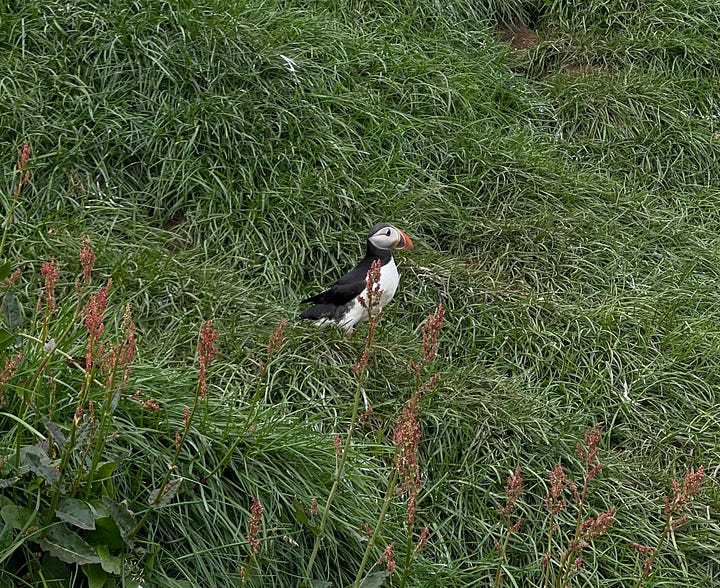
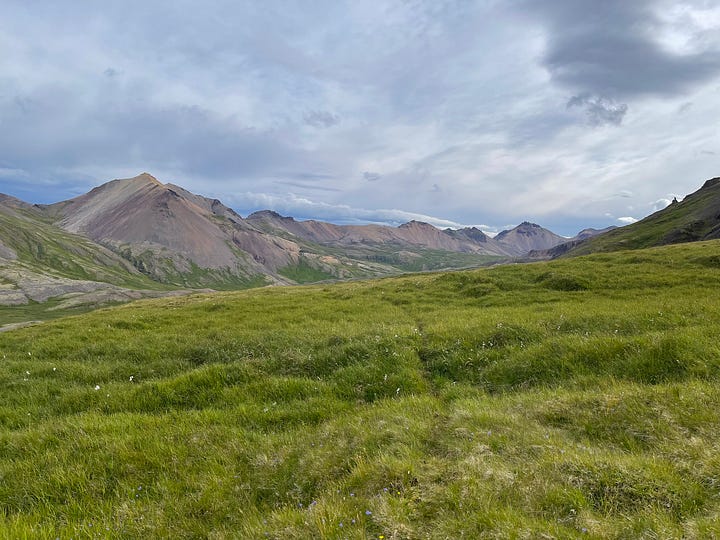
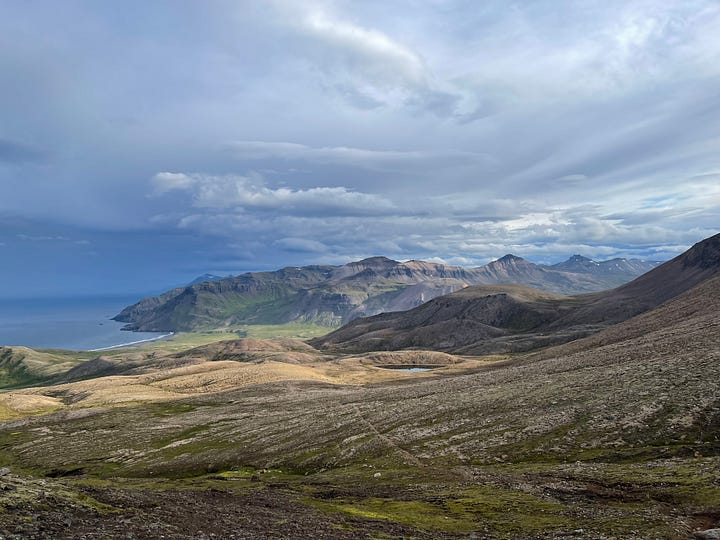
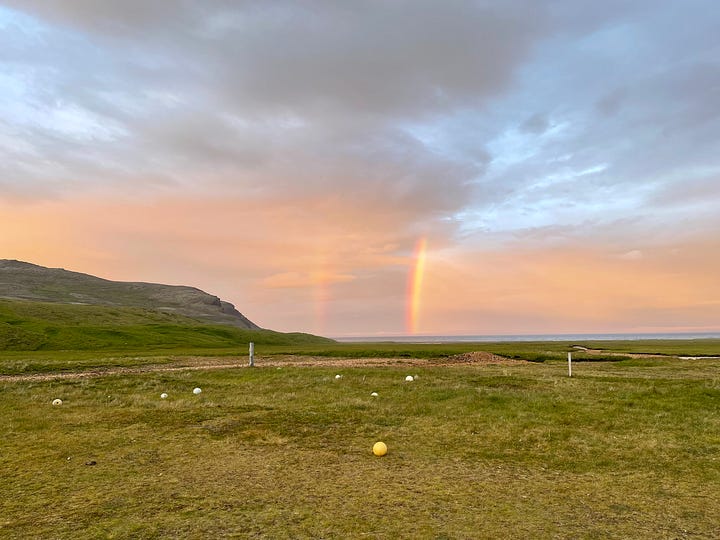
I soon arrived at the guesthouse in Breiðuvík. The route I'd chosen was a four-day, hut-to-hut through-hike from Bakkagerði to Seyðisfjörður. But I wasn't going to sleep indoors. This was my final solo trek of the summer; this was my last chance to prove myself, to myself. Did I finally have it all figured out? I set up my tent on the lawn between the guesthouse and the inlet's beach. Then, out of the water on the horizon, emerged two short, near-vertical segments of a double-rainbow. As the light faded, so too the rainbow, but back toward Bakkagerði, behind the guesthouse, there was this brilliant and slow Arctic sunset. Each bushy indigo cloud was backlit by a bold orange, the color of a puffin's beak. From inside my tent, I could hear a raucous group inside the hut, and I could smell the meal they were cooking.
Autumn
Like a prey-animal, I waited until the group had left the hut before packing up and heading inside to scavenge leftovers, after the on-site warden invited me to do so. It was spacious and toasty in there: hardwood floors and hardwood furniture, multiple bunk rooms, and a kitchen with an oven. I boiled a pot of water to cook up a glutenous amount of pasta, and I snacked on their abandoned, half-eaten packages of cookies until the pound of pasta was overcooked. In the ursine community, this practice is called hyperphagia: overeating in preparation for a period of inactivity. At some subconscious level, I must have known that Winter was coming.
There was a dense fog throughout my second day hiking Víknaslóðir. The vibrant colors had already been their brightest; now they were dimming. The fog made it hard to track the footpath, so I spent a lot of the day bushwhacking, trying to find my way back to the trail. There was this one haunting moraine in a thin valley that lead to the beach. The fog had settled in there such that I could only see the nearest blue sliver of the ocean but not the horizon. There were huge boulders scattered about, which had not moved since the last ice age. What could carry such a heavy thing other than a glacier? At one point, bushwhacking, I fell trying to scale down a steep grade and scraped my knee. It had started to drizzle, so the ground was loose. Thoughts of the moraine had distracted me. And maybe the pasta had encumbered me. Or maybe I had been rushing for no good reason and had stumbled over my own hurry.
In Húsavík, I stopped short of the hut and took a side-road that led toward the beach. Coming the other way was a four-person sub-group of the hut-dwellers. The Icelandic hikers were kind and greeted me. One woman stopped to warn me about the storm that was coming and encouraged me to pay for a bunk inside the hut. She assured me that I wouldn't be crashing their party. I politely declined and committed to wild-camping that night, no matter the weather. And I walked on, eager to get out of earshot of the chattering group.
They were on their way back from the Húsavík chapel, and they encouraged me to visit. Without that assurance, I wouldn't have known that I was allowed to climb the step-ladder and vault the fence of what looked like a deserted property. The only building intact was this red-roofed chapel, which was on a short cliff above a banana-shaped, black-sand beach.
Inside, silence was holding a meeting with its dear friend stillness. There were four total rows of pews, two narrow columns; I didn't permit myself to sit until I had stopped dripping. The Jesus iconography moved me more than usual as I peered up at Him from the third or fourth row. I sat there, still, and expressed gratitude to whatever amorphous conception of God I could conjure in the moment. In other words, I prayed. I made the humble request to Her that I may be granted more moments like this in life, that I may be open enough to receive shelter from the storm when it appears, and that I may enjoy it no matter how fleeting the relief may be.
I assumed that the hut-dwellers had not noticed the guestbook by the door, because they hadn't signed it. I was still alone and nearly dry again, but the crowded guestbook made me feel like my prayer had been aided by intercession. At least one visitor had signed every day for the previous several weeks, and only the visitors from the previous several days could have fit in those pews comfortably.
The temperature had plummeted, and the rain had picked up. At this point in the season, even at this northern latitude, the Sun does fully set, and darkness rises from the opposite horizon. The storm was churning, and I pitched my tent with urgency, having found a good-enough spot in a semi-dry ditch beside the road, between the silent chapel and the hut-party. It was not even 8:00 pm, but there was no sense in staying outside in the wind and rain. Bears, groundhogs, frogs, and queen bees know this better than I: the fruition of my ambition requires stillness. So, I burrowed into my hibernaculum for the night.
Winter
I have learned that it is merely colloquial and unscientific to say that bears hibernate. Technically, the state they enter is called torpor, during which a bear's metabolism and body temperature drop and it sleeps for days to months at a time without eating or passing waste. But a torpor is not complete dormancy. And thanks to that pound of pasta I had for breakfast, I was prepared to enter this state myself.
Each raindrop resounded like a snare-hit on the nylon-canvas drum of my tent's taught roof. The orchestra's percussion section had abducted me, and I was tied down inside the pit. The wind section, however, was performing everywhere else: up in the balcony, throughout the mezzanine, and down every aisle. They were spitting at me from afar. The percussion didn't prevent me from sleeping; it was the frigid, forceful winds.
I was clothed in every layer I had and was zipped all the way into my sleeping bag. I thought about layering on my second pair of socks, but I decided against it for how much warmth it would cost me to unzip my sleeping bag an inch, how much it would cost me to move a muscle. It was not deathly or dangerously cold, just the coldest it had been all summer. I couldn't escape the sensation of it in any waking moment. And when I would drift into sleep, I'd be jolted awake by forceful wind whacking me in the head by caving in the nearest tent-pole.
I needed to sleep, so that my body temperature could drop and my face wouldn't feel so cold. I needed to sleep so that I could dream. For in dreams I can finally focus and remind myself what matters, even if it only happens unconsciously. I needed to dream so that, later, I could achieve.
I had eaten dinner inside my tent. I had slept as much as possible. And in the morning, it was still raining and still cold enough that I didn't want to move. I did not unzip my sleeping bag, did not disrobe, did not drink, and I tried not to stir so that I wouldn't feel the pain of needing to urinate. I laid there and read a book with gloves on until I was warm enough to emerge. When my torpor ended, it was 11:00 am the next day.
I hiked into the wind all the way up the switchbacking mountain road and was only sheltered from it when I made it down into Loðmundarfjörður. On the ridge between two fingerling fjords, a sudden gust swept my ball-cap off my head. I sprinted downhill, off the trail, and grabbed it before it was lost to the fjord. I didn't fall and hadn't littered, but I had trampled a patch of delicate moss that had spent its entire existence dreaming of reaching these heights — the same moss I had successfully avoided for the previous 58 days. I paused for a moment and asked for forgiveness.
The black basaltic peaks above Loðmundarfjörður had these snow deposits that looked oddly melted. I couldn't figure it out; the white was speckled and streaky but still clearly there — not like the snow on the peaks near Bakkagerði. Why do they look like that? I thought. So dusty.
At the final hut on this trek, I was reunited with the raucous group. They were considerate, especially the four that I'd seen near the chapel. Many of the 20 Icelandic hikers insisted on sharing from their buckets and boxes of food: cheese and crackers, cheese and sausage, dried fish (Harðfiskur), and a variety of chocolate. That one woman was worried about me again. She wondered how I'd fared the previous night, camping out in the storm. She explained that it had snowed atop the mountains. I guess I had never seen fresh snow on a dry peak. Those dusty, white streaks were what remained of the first snow of the summer.
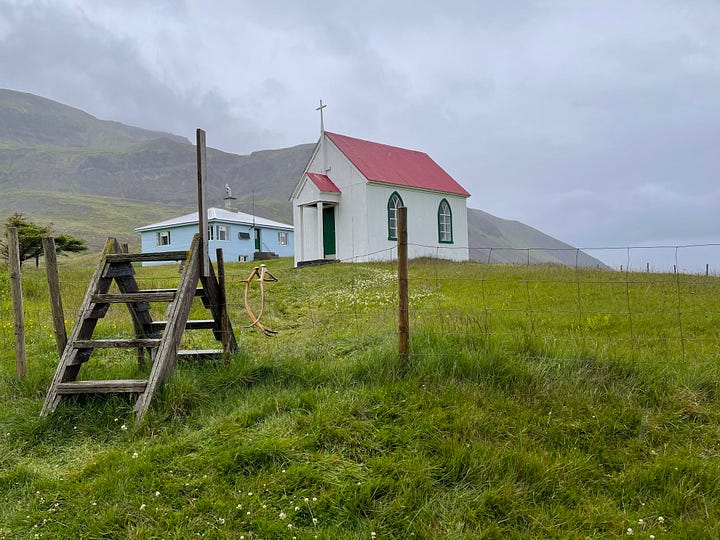
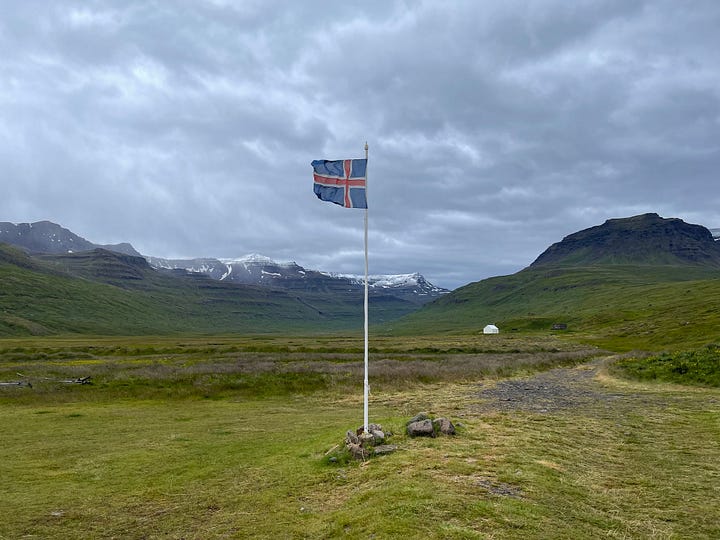
I paid to camp in the lawn again so that I would have access to the toilet and the outdoor kitchen, which was covered in a thick-canvas tent with plastic windows. While I was scavenging, a man arrived at the hut on a bicycle. He was alone.
was on assignment, and his employer had paid for his ticket to the hut-party. But after getting an exclusionary vibe from the group, he joined me in the kitchen.Kevin hand-rolled and smoked a cigarette as we spoke. He was commissioned by the Guardian to bike from Britain to Iceland, an adventure that he had pitched to the publication as their chief travel writer and from which he would produce a series of four articles. Kevin has been a salaried writer for the Guardian for twenty years, and he's covered it all: rhino conservation in Zimbabwe, kayak-camping in Sweden's Saint Anna archipelago, documenting endangered leopards in Yemen, traveling to Iceland without a plane. We spoke about the concept of paradise, the decline of presence in a media-driven world, how to maintain individuality in a romantic relationship, how to make a career as a writer and how to chase down a story (which are one in the same2). Learning about Kevin's life made me want to publish books and get paid to go on adventures around the world. His cigarette smoke billowed out of the tent, heralding a new mountain of rhyolite lava, and I didn't mind the smell.
The next morning, I knocked on the door of the warden's cabin to pay for my night's stay. Eydís invited me in for tea. She taught me about the region and the significance of Seyðisfjörður as a port. She told me about her late husband. In her retirement, she had decided to spend her summers working at the mountain huts around Iceland, surrounded by beauty and helping others access it. Even from our short interaction, I knew I wanted to become more liker her: spilling out broad layers of basaltic lava to give others new ground to stand on; happy to be still.
I had been a volcano in dormancy, and these two — Eydís and Kevin, one effusive and the other explosive — were helping me dream of the mountains I might make one day.
Spring
It was windy and rainy again, but it didn't seem to matter. My ambition had never been to arrive at my destination easily but to choose a journey that I would enjoy regardless of its difficulty. Drenched and smiling into head-on winds, I paused to get prone and drink three sips from the waterfalls. Next to one stream, there were three sheep, two white and one black sheep, higher up, that I would not have noticed if I had been in a hurry. I continued hiking and caught drops of sideways rain on my tongue.
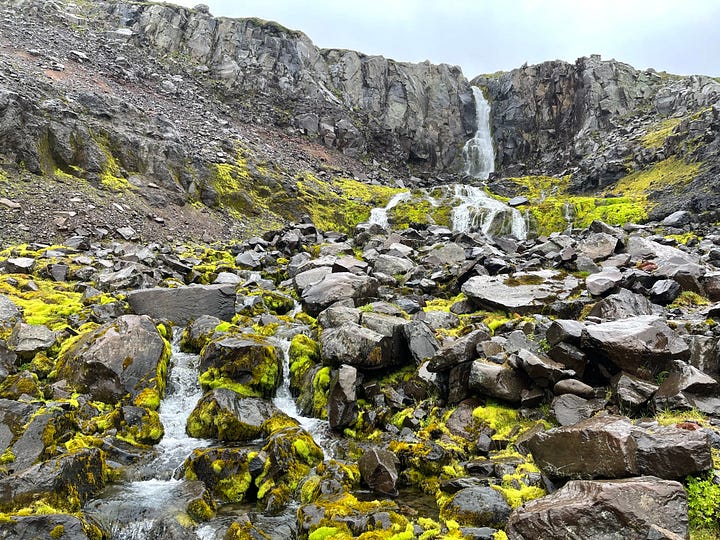
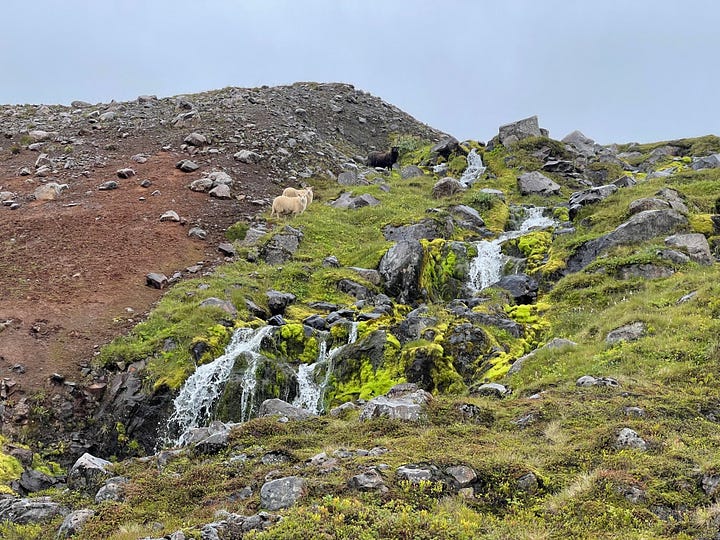
When I had tried harðfiskur for the first time, the night before, it had been bland. But I learned on my descent into Seyðisfjörður that under certain circumstances and with a certain attitude, those dehydrated pieces of cod fillet could have a rich and complex flavor, like that of an exotic melon. My pruned, soaked fingers were rehydrating the harðfiskur such that the pieces were spongy, and I worried they would spoil if I left them wet like that until the morning. So, I treated myself to the entire 200 grams of ripen fruit.
Bounding down the mountain slope, I landed on a gravel road, still miles from town of Seyðisfjörður. The gravel soon turned to asphalt, and stepping on it felt like it would to stomp on winter-hardened topsoil. I was already wishing to be back up on that mountain, buffeting in the wind and rain again.
Springboard
A carefully crafted question to help you dive inwards:
Do you need more sleep or bigger dreams?
As always, I’d love to hear from you, either in the comments or via email. How does the theme of duality show up in your life? What is your next adventure?
Thank you for reading,
P.S. This was the final chapter in a five-part series on the 81 days I spent trekking through Iceland, called “Feeling Fire & Ice.” And it is a major personal milestone to hit “Publish” on this one. This series has been a 15-month project. For a while, I was feeling down about how long it was taking, but I’ve realized that I needed to become a much better writer to tell these stories the way I want. Isn’t that fitting? My ambition required stillness.
These five essays have helped me reach a new standard of quality for my writing, and I now feel ready to write a book about my time in Iceland. That project starts today.
Thank you to everyone who has been following along with this series. While I work on the book, I’ll still be publishing essays on other topics. And if you’d like to read the other essays in this series, here is the contents:
Preface: Feeling Fire & Ice
I. Hubris & Humility
Akranes to Thingvellir – A first-time backpacker's blunders
II. Majesty & Mortality
Vatnaleið to Hellissandur – Beneath an ancient glacier, grappling with my cosmic insignificance
III. Neuroticism & Naïveté
Hellissandur to Brjánslækur – What I learned from getting robbed in Iceland
IV. Solitude & Company
Isafjörður to Veiðileysufjörður – Alone in the most remote region of Iceland
V. Stillness & Ambition
Borgarfjörður to Seyðisfjörður – I needed to sleep so that I could dream. I needed to dream so that, later, I could achieve.
Footnotes
This mini geology lesson is brought to you by Burchardt, et al: Burchardt, S., Oskarsson, B., Gustafsson, L., Berg, S. E. and Riishuus, M. S. (2022) “Geology of a Neogene caldera cluster in the Borgarfjörður eystri–Loðmundarfjörður area, Eastern Iceland”, Volcanica, 5(1), pp. 133–161. doi: 10.30909/vol.05.01.133161.
Hence my omission of the Oxford Comma






…what a legendary land you roll through…to answer your closing prompt, i will cheat a bit, and say less about duality and more about more-ality…the idea of being multitude and aligned or apart sits with me often…i am struck between deciding to be an optimistic cynical pessimist and/or a cynically pessimistic optimist…all roads point in all directions depending on the type of compass i use…how many things can we be at once…and if we live in the limbo of thought or confliction is that a singular plural?…if my light shines on my dark does it cancel or illuminate it…i suppose it is always the chosen angle…
Great work! Reading it felt much like what I imagined your trip in Iceland to be like—it put me in such a meditative state. I love the way you see the world around you!